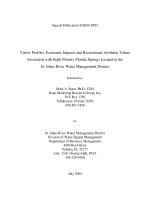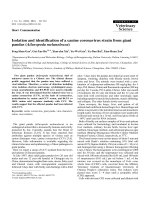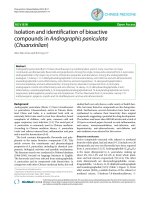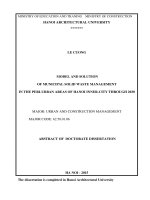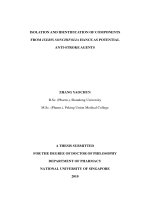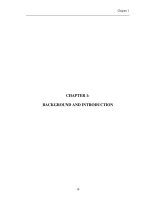Isolation and identification of fungi associated with composting process of municipal biosolid waste
Bạn đang xem bản rút gọn của tài liệu. Xem và tải ngay bản đầy đủ của tài liệu tại đây (3.08 MB, 8 trang )
Journal of Biotechnology 15(4): 763-770, 2017
ISOLATION AND IDENTIFICATION OF FUNGI ASSOCIATED WITH COMPOSTING
PROCESS OF MUNICIPAL BIOSOLID WASTE
Pham Thi Thu Hang*, Le Thi Quynh Tram, Tran Phuong Anh, Ho To Thi Khai Mui, Dang Nguyen
Thao Vi, Dinh Hoang Dang Khoa
Institute for Environment and Resource (IER), Vietnam National University Ho Chi Minh City
*
To whom correspondence should be addressed. E-mail:
Received: 28.11.2017
Accepted: 28.12.2017
SUMMARY
Organic waste is gradually degraded during composting process, producing carbon dioxide, water, heat,
and humus, the relatively stable end product. The degradation process is carried out by living organisms, of
which fungi appear to have the most important role since they break down tough debris (cellulose, lignin, and
other resistant materials), enabling other microorganisms to continue the decomposition process. The objective
of this study was to isolate and identify the fungi associated with large scale municipal biosolid waste
composting process in Vietnam. In this study, we have isolated 10 morphologically different fungal strains
from the composting materials, and classified based on morphological characteristics and 18S rDNA
sequences. The results showed that these fungal strains belonged to four different genera, including
Aspergillus, Penicillium, Monascus, and Trichoderma. The results would be a useful reference for further
studies of diversity, and functions of fungi that involved in municipal biosolid waste composting process in
Vietnam environmental conditions.
Keywords: Composting, fungal biodiversity, morphological classification, 18S rDNA
INTRODUCTION
Composting technology has been widely used to
treat biosolid waste, producing fertilizer for soil. The
process is based on activities of variety of
microorganisms, among those fungi play important
roles due to their ability to degrade a wide range of
ligno-cellulosic materials (Kumar et al., 2008), the
major component of plant cells and the most
abundant renewable organic resource. The lignocellulosic materials are composed of three types of
polymers, namely cellulose, hemicelluloses, and
lignin which are strongly engaged and persistent
(Howard et al., 2003). In municipal biosolid wastes,
ligno-cellulosic materials such as paper, carton,
vegetable, and garden wastes are the major
components. During composting process, fungi
involve mainly at first (starting) mesophilic, and
second (curing) mesophilic phase due to their low
heat tolerance in comparing with bacteria (Insam, de
Bertoldi, 2007). Fungi of genera Aspergillus,
Microsporium,
Trichophyton,
Yeast,
Mucor,
Penicillium, Rhizopus, Fusarium, Cladosporium, and
Curvularia were reported dominant in composting
process of forest litter (Song et al., 2010), rice straw
(Hefnawy et al., 2013), and household waste
(Dehghani et al., 2012). However, little is known
about main fungal groups existing in municipal
biosolid waste composting at industrial scale in
environmental conditions of Vietnam. Therefore, the
objective of this study was to isolate and identify
fungi which are associated with industrial scale
municipal biosolid waste composting process.
MATERIALS AND METHODS
Sample collection
Compost samples were collected at municipal
waste composting factory in Binh Duong province.
At the factory, the municipal biosolid waste
underwent composting process in 100 ton piles with
continuous aerating. The compost samples were
collected at the surface and 25-cm depth of a
composting pile at the 1st, 10th, 20th, 25th, 35th, 42th
day during composting process, and finished
763
Pham Thi Thu Hang et al.
compost material (app. 90th day). The samples were
quickly transported to laboratory for analyzing.
Temperature of each sampling point was recorded
with a thermometer.
Isolation and morphological classification
Three gram of composting material was
suspended in 27 mL of 0.9% NaCl solution for 30
min with gently shaking at 200 rpm. After that, 100
µL of three consecutive dilutions was pipetted onto
and spread evenly over petri plates containing Potato
Glucose Agar (PGA) medium supplemented with
chloramphenicol (100 mg/L), then incubated at
32°C, in the dark for 5 to 7 days. Single colonies
were picked up and streaked on new PGA plates.
After 2 days when the colonies visibly grew, but
conidia had not yet been produced, 5 mm-diameter
agar plugs were taken at the actively growing edge
of the colony and transferred to fresh GPA plates,
put in the position mycelia-side-down and at a
distance of approximately 1.5 cm from the edge (or
center) of the plates. Colony characteristics such as
colony radius, colony appearance, time of first
appearance of conidia, and type of pigmentation in
the medium or conidia were recorded. Macromorphological observation was carried out within 1
week. Micro-morphological characteristics such as
vigorous
growth
of
mycelium
structure,
conidiophore, phialide and conidia were recorded for
3-5 day old pure-cultures, depending on the growth
rate of strains by using slide culture method and
lactophenol cotton blue stain following Benson’s
procedure (Benson, 2002). The purified strains were
classified based on their macro- and micromorphological characteristics (Domsch et al., 1980).
Genomic DNA extraction
Genomic DNA of fungal strains was extracted
using a modified method of Feng et al. (2010). From
cultures on PGA plates, 20 mg of fungal mycelia
was collected into 1.5 mL tubes containing 0.2 g
glass bead (0.1 mm diameter), and 650 µL of lysis
buffer (100 mM Tris-HCl, pH 8.0; 50 mM EDTA,
pH 8.0; 1% SDS; 10 µg/mL RNase A). The mixture
was vortexed for 2 min, then centrifuged at 10,000
rpm for 5 min. After centrifugation, 500 µL of
supernatant was transferred into a new tube
containing 100 µL of sodium acetate buffer (3.0 M,
pH 5.5), and 500 µL of isopropanol, mixed and
centrifuged at 10,000 rpm for 5 min to precipitate
fungal DNA. DNA pellets were washed with 70%
ethanol, air dried, then dissolved in 50 µL of sterile
764
distilled water. The quality of extracted DNA
samples was tested by spectrophotometer and gel
electrophoresis.
Polymerase chain reaction (PCR) to amplify 18S
rDNA
A variable region (app. 750 bp length) of 18S
rDNA gene was amplified with primer pair NS1 (5’
– TAGTCATATGCTTGTCTC – 3’) (White et al.,
1990)
and
Fung5
(5’
–
GTAAAAGTCCTGGTTCCCC – 3’) (Smit et al.,
1999). The PCR mixture (25 µL) contained
approximately 50 ng of template DNA, 0.5 U DNA
Taq-polymerase (MyTaq-Thermo scientific), 1×
MyTaq PCR reaction buffer (MyTaq-Thermo
scientific), and 20 pmol of each primer. A
thermocycling was performed using a MyCycler
Thermal cycler (Bio-Rad, UK) as follows: 94oC/5
min, followed by 30 cycles of (94oC/30 s, 47oC/40 s,
72oC/90 s), then 72oC/5 min. After that, PCR
products were analyzed by electrophoresis on 1.5%
agarose gel, stained and observed under UV light.
18S rDNA Sequencing and Phylogenetic tree
building
PCR products were purified and sequenced by
ABI PRISM® 3730XL Analyzer (Macrogen
sequencing service). The obtained sequences were
then analyzed with Bioedit version 7.25 software and
compared with 18S rDNA sequences available at
NCBI database using Basic Local Alignment Search
Tool (BLAST). The distance matrix for all pairwise
sequence alignments was analyzed with the
neighbor-joining (NJ) method of phylogenetic tree
construction with 1,000 bootstrap replicates by using
MEGA version 6 software.
RESULTS
Fungi isolation and classification
From the samples collected at different stages of
composting process, 10 fungal strains of different colony
morphology were purified. Detail analyses of macro- and
micro-morphological characteristics showed that these
10 fungal strains belonged to 4 genera, including
Aspergillus, Penicillium, Trichoderma, Monascus. In
more details, 7 of these strains were belonged to the
genus Aspergillus, 1 strain to Penicillium, 1 strain to
Trichoderma and 1 strain to Monascus (Table 1).
The results of 18S rDNA sequence analysis
of these 10 strains were in agreement with
morphological classification, i.e. they belonged
to four genera Aspergillus, Trichoderma,
Monascus, and Penicillium (Table 1). A
phylogenetic tree was constructed with MEGA
software to overview their relationship (Figure
1), supporting that 18S rDNA sequencing is an
useful tool for fungal identification (Smit et al.,
1999).
A1
A2
A3
B1
C1
C2
C3
D1
E1
E2
G1
G2
G3
I2
I3
I1
B2
D2
F1
E3
B3
D3
F2
H1
F3
H3
H2
J1
J2
J3
Figure 1. Colony morphology of fungi (front and reverse) on PGA plates at 32ºC after 5-7days and micrographs of their
conidiophore. (A): Strain I; (B) Strain II; (C) Strain III; (D) Strain IV; (E) Strain V; (F) Strain VI; (G) Strain VII; (H) Strain VIII; (I)
Strain IX; (J) Strain X. Scale bars: A3= D4=E3=I3=50 µM; B3= C3=F3=20 µM; G3=100 µM; H3=H4=J3=10 µM
Table 1. Macroscopic and microscopic characteristics of the 10 fungal strains isolated from industrial scale – municipal
biosolid waste composting piles in Binh Duong, Vietnam. In the table, the fungi with similar characteristics were grouped
together.
Macroscopic characteristics
Strain
Colony
radius
after 72
h (mm)
Color
Time of
first
Reverse observe
d
color
conidia
(h)
Pigmentation
on medium
Microscopic characteristics
Conidiophores
Diameter
of
conidia
(µm)
Shape of Identify
conidia
765
Journal of Biotechnology 15(4): 763-770, 2017
57
Powdery
and
Yellow black
24
green
bluegreen
Yellow green
57
Powdery
and
Grey
black
green
bluegreen
24
None
59
Powdery
and
Light
black
green
bluegreen
24
Light
green
VI
60
Powdery
and
Light
black
green
bluegreen
24
Light
green
V
50
Black
White
24
None
VII
47
Black
White
24
None
19
Velvety
green
Light
orange
48
Light
orange
I
II
III
IV
VIII
IX
X
75
77
26
Green
White
White to
yellow
2.5-3.1
Conidiophores terminate in a
vesicle covered with either a single
palisade-like layer of phialides
(uniseriate). The vesicle, phialides,
and conidia form the conidial head.
The phialides usually forming on
the upper two-thirds of the vesicle.
1.9 -3.0
2.0-3.0
Globose to
subglobos
e in chains
and form
compact
columns
(columnar)
.
Aspergillus
sp.
2.5-2.7
Conidiophores are long with
spherical vesicles. Conidiophore is
biserate - metulae just about cover
the entire surface from which the
phialides extend.
Conidial heads support vesicles
which are biseriate with metulae
and phialides covering half to the
entire vesicle. Conidial heads were
radiated.
3.0-4.0
Globular
or
ellipsoidal
3.5-5.0
Globular
or
ellipsoidal
2.0-3.5
Round
and form
short
chains
Yellow 36
green
Conidiophores are rather short, are
Yellow - repeatedly branched at wide angles
2.0-4.0
(approaching 90o), bearing clusters
green
of divergent flask-shaped phialides.
White to
24
red
Red
Nonostiolate ascomata arising
singly at the tip of stalk-like hyphae
scattered on the mycelium, and an
ascomatal wall composed of two
distinct layers, an inner layer which
results from the swelling of the tips
of the stalk-like hyphae forming a
vesicle-like structure and an outer
layer, hyaline and ellipsoidal
ascospores liberated from the
cleistothecia
Yellow
Conidiophore have a cluster of
branches, each bearing a cluster of
phialides (biverticillate). Phialides
grouped in brush-like clusters
(penicilli) at the ends of the
conidiophores.
White to
48
yellow
Spherical
to
ellipsoidal Trichoder
ma sp.
form
sticky
clumps
5.0–15
Globose
to
obovoid
or
obpyrifor
m
2.5-5.0
Globose
or
ellipsoidal Penicillium
and form sp.
long dry
chains
Monascus
sp.
766
Journal of Biotechnology 15(4): 763-770, 2017
Table 2. Results of 18S rDNA sequences analysis of the 10 fungal strains isolated from compost material in comparison to
the available sequences on NCBI database using BLAST algorithm.
Length of 18S rDNA
sequence (bps)
Query Coverage (%)
Identity (%)
631
100%
100%
Aspergillus sp. ISSF-T021
638
100%
100%
Aspergillus sp. ISSFT-021
638
100%
100%
Aspergillus sp. ISSFT-021
659
99%
99%
Aspergillus versicolor
V
636
100%
100%
Aspergillus sp. PSFNRH-2
VI
638
100%
100%
Aspergillus fumigatus
644
100%
100%
Aspergillus sp. CC-FB1
634
100%
100%
Trichoderma sp. S1102
665
100%
99%
Monascus purpureus
or Monascus ruber
945
100%
100%
Pennicillium sp. SCS-KFD08
Strain
I
II
III
IV
VII
VIII
IX
X
18S rDNA identification
Figure 2. Phylogenetic tree was constructed with 18S rDNA sequence of the isolated fungi and related species using
neighbor-joining method (MEGA 6 software). Numbers at branches are bootstrap values of 1,000 replications. The scale bar
is in fixed nucleotide substitution per sequence position.
767
Journal of Biotechnology 15(4): 763-770, 2017
DISCUSSION
During composting process, organic materials in
municipal waste is converted into useful organic
manure by microorganisms, among those fungi are
important because they can decompose plant derived
ligno-cellulosic materials (Kohzu et al., 2005). In
this study, morphological and 18S rDNA
classification analyses have been consistently
showed that the common fungal strains in municipal
biosolid waste composting process were Aspergillus,
Penicillium, Monascus, and Trichoderma. Our
observation was in agreement with the previous
reports, indicating the abundance and important of
these four fungal genera in composting process of
bio-organic materials (Anastasi et al., 2005; Eida et
al., 2011). The thermotolerance and capacity to
degrade a wide range of organic waste of
Aspergillus, Penicillium fungi may be the reasons for
their dominant in bio-organic composting process
(Miller, 1996).
In consistence with previous study, the data of our
study showed that 7 out of the 10 fungal strains were
identified as Aspergillus, suggesting that Aspergillus
was the most common group in the investigated
composting process (Ashraf et al., 2007). The fungi of
Aspergillus genus can survive in many different
environmental conditions, and possess diverse
hydrolytic enzymes (amylase, protease, cellulase),
therefore the fungi can degraded variety organic
compounds, even complex organic compounds like
lignin and cellulose, and play important roles in the
composting process (Hawksworth, 2011). Besides
Aspergillus, fungi of the other three genera have been
also known for their ability to promote the speed and
efficacy of composting process. Fungi of
Trichoderma, and Penicillium genera have also been
reported for participation in degrading a wide range of
organic compounds in composting process. Recently,
Penicillium expansum W4, a fungal strain producing
ligno-cellulase, has been reported to be able to
improve the quality and efficiency of composting
process (Wang et al., 2011). In another study,
Trichoderma atroviride has improved humic acid
content in the mature compost by degradation of
lignin and cellulose, xylan compounds (Maji et al.,
2015). Fungi of Mucor genus have been report as the
most dominant fungal genus in sawdust compost,
representing 50% (9/18) of all isolates, and have high
β-glucanase, mannanase, and protease activities
(Hefnawy et al., 2013) and household waste
(Dehghani et al., 2012).
Beside the ability to improve the efficacy and
quality of composting process, fungi also play
significant roles in protection of plants against
pathogenic fungi. Aydi-Ben Abdallah et al. (2014)
has reported that Pythium leak disease on potato
caused by Pythium ultimum was controlled by
culture filtrates and organic extracts from
Aspergillus spp., originated from compost. The
research of Makut and Owolewa (2011) showed that
Penicillium sp. and Aspergillus sp. had the ability to
inhibit the fungal pathogen Candida albicans. It is
well known that Trichoderma sp. have the ability to
antagonize different plant pathogens such as
Fusarium sp., Pythium sp., Rhizoctonia sp., and has
been widely used in agriculture. Moreover,
Trichoderma can enhance the plant growth and
development, as well as support plants to respond to
stress conditions such as drought and soil salinity.
CONCLUSION
In conclusion, the results of this study have
revealed that fungi of four genera Aspergillus,
Penicillium, Monascus, and Trichoderma were
associated with municipal biosolid waste composting
process at industrial scale in Vietnam. It is call for
further study for better understanding of their roles
in degradation of organic compounds in composting
process, and maturation of composting materials.
The understanding of composting-associated fungi is
necessary for carrying out monitor and their
utilization to improve the performance of industrial
biosolid composting process.
Acknowledgements: This research is funded by
Vietnam National University of Ho Chi Minh City
(VNU-HCM) under grant number C2016-24-04/HĐKHCN. We would like to thank South Binh Duong
Solid Waste Treatment Complex for supports in
collecting compost samples.
REFERENCES
Anastasi A, Varese GC, Filipello Marchisio V (2005)
Isolation and identification of fungal communities in
compost and vermicompost. Mycologia 97(1): 33-44.
Ashraf R, Shahid, F, Ali TA (2007) Association of fungi,
bacteria and actinomycetes with different composts. Pak J
Bot 39(6): 2141-2151.
Aydi-Ben Abdallah R, Hassine M, Jabnoun-Khiareddine
H, Haouala R, DaamiRemadi M (2014) Antifungal activity
768
of culture filtrates and organic extracts of Aspergillus spp .
against Pythium ultimum. J Plant Ptotec 9: 17-30.
Benson HJ (2002) Microbial Applications - A Laboratory
Manual in General Microbiology, 8th ed. The McGrawHill Company.
Domsch KH, Gams W, Anderson TH (1980) Compendium
of soil fungi. London, England: Academic Press. 865 p.
Dehghani R, Asadi MA, Charkhloo E, Mostafaie G,
Saffari M, Mousavi GA, Pourbabaei M (2012)
Identification of fungal communities in producing compost
by windrow method. J Environ Prot (Irvine, Calif) 3: 6167.
Eida MF, Nagaoka T, Wasaki J, Kouno K (2011)
Evaluation of cellulolytic and hemicellulolytic abilities of
fungi isolated from coffee residue and sawdust composts.
Microbes Environ 26(3): 220-227.
Feng J, Hwang R, Chang KF, Hwang SF, Strelkov SE,
Gossen BD, Zhou Q (2010) An inexpensive method for
extraction of genomic DNA from fungal mycelia. Can J
Plant Pathol 32(3): 396-401.
Hawksworth DL (2011) Naming Aspergillus species:
progress towards one name for each species. Med Mycol
49: S70-76.
M, Wada E (2005) Dynamics of 13C natural abundance in
wood decomposing fungi and their ecophysiological
implications. Soil Biol Biochem 37 (9): 1598–1607.
Kumar R, Singh S, Singh OV (2008) Bioconversion of
lignocellulosic biomass: biochemical and molecular
perspectives. J Ind Microbiol Biotechnol 35(5): 377-391.
Maji D, Singh M, Wasnik K, Chanotiya CS, Kalra A
(2015) The role of a novel fungal strain Trichoderma
atroviride RVF3 in improving humic acid content in
mature compost and vermicompost via ligninolytic and
celluloxylanolytic activities. J Appl Microbiol 119(6):
1584-1596.
Makut MD, Owolewa OA (2011) Antibiotic-producing
fungi present in the soil environment of keffi metropolis,
Nasarawa state, Nigeria. Trakia Journal of Sciences 9(9):
33-39.
Miller FC (1996) Composting of municipal solid waste and
its components. In Palmisano AC, Barlaz MA, eds.
Microbiology of Solid Waste. CRS Press: 115-154.
Smit E, Leeflang P, Glandorf B, Van Elsas JD, Wernars K
(1999) Analysis of fungal diversity in the wheat
rhizosphere by sequencing of cloned PCR-amplified genes
encoding 18S rRNA and temperature gradient gel
electrophoresis. Appl Environ Microbiol 65(6): 2614-2621.
Hefnawy M, Gharieb M, Nagdi OM (2013) Microbial
diversity during composting cycles of rice straw.
International Journal of Advanced Biological and
Biomedical Research 1(3): 232-245.
Song F, Tian X, Fan X, He X (2010) Decomposing ability
of filamentous fungi on litter is involved in a subtropical
mixed forest. Mycologia 102 (1): 20-26.
Howard RL, Abotsi E, Jansen van REL, Howard S (2003)
Lignocellulose biotechnology: issues of bioconversion and
enzyme production. Afr J Biotechnol 2(12): 602-619.
Wang HY, Fan BQ, Hu QX, Yin ZW (2011) Effect of
inoculation with Penicillium expansum on the microbial
community and maturity of compost. Bioresour Technol
102 (24): 11189-11193.
Insam H, de Bertoldi M (2007) Microbiology of the
composting process. In Diaz LF, de Bertoldi M,
Bidlingmaier W, Stentiford E, eds. Compost Science and
Technology. Waste Management Series: 25-48.
Kohzu A, Miyajima T, Tateishi T, Watanabe T, Takahashi
White TJ, Bruns T, Lee S, Taylor J (1990) Amplification
and direct sequencing of fungal ribosomal RNA genes for
phylogenetics. In Innis MA, Gelfand DH, Sninsky JJ,
White TJ, eds. PCR Protocols: A Guide to Methods and
Applications. Academic Press: 315-322.
PHÂN LẬP VÀ ĐỊNH DANH CÁC VI NẤM THAM GIA VÀO QUÁ TRÌNH Ủ COMPOST
CHẤT THẢI RẮN SINH HOẠT ĐÔ THỊ
Phạm Thị Thu Hằng, Lê Thị Quỳnh Trâm, Trần Phương Anh, Hồ Tô Thị Khải Mùi, Đặng Nguyễn
Thảo Vi, Đinh Hoàng Đăng Khoa
Viện Môi trường và Tài nguyên, Đại học Quốc gia Thành phố Hồ Chí Minh
TÓM TẮT
Trong quá trình ủ compost, các chất thải rắn có nguồn gốc sinh học sẽ bị phân hủy bởi các vi sinh vật,
tạo ra carbon dioxide, nước, nhiệt và các chất mùn (compost). Trong các vi sinh vật, nhóm vi nấm có vai trò
quan trọng trong việc phân giải các hợp chất bền vững như cellulose, lignin và các vật liệu khác. Mục tiêu của
nghiên cứu này là phân lập và xác định các nhóm vi nấm tham gia vào quá trình ủ compost chất thải rắn sinh
học đô thị ở quy mô công nghiệp tại Việt Nam. Chúng tôi đã quan sát thấy có 10 chủng vi nấm có sự khác biệt
769
Pham Thi Thu Hang et al.
về hình thái hiện diện trong quá trình ủ compost, các chủng vi nấm này sau đó được định danh dựa trên các
phân tích chi tiết về hình thái và trình tự 18S rDNA của chúng. Kết quả thí nghiệm cho thấy các chủng vi nấm
chiếm ưu thế thuộc về bốn chi khác nhau bao gồm Aspergillus, Penicillium, Monascus và Trichoderma. Các
kết quả này sẽ là dữ liệu tham khảo hữu ích cho các phân tích sâu hơn về sự đa dạng và chức năng của các vi
nấm trong quá trình phân hủy chất thải rắn sinh học đô thị ở Việt Nam.
Từ khóa: Chất thải rắn hữu cơ, phân compost, đa dạng sinh học vi nấm, quy mô công nghiệp, phân loại hình
thái, 18S rDNA.
770
